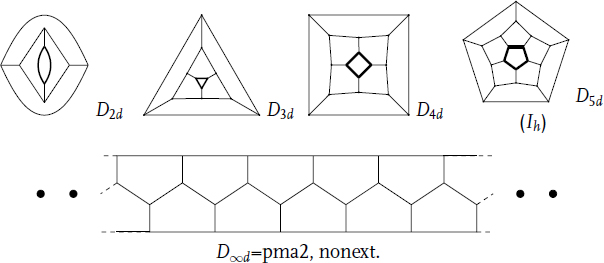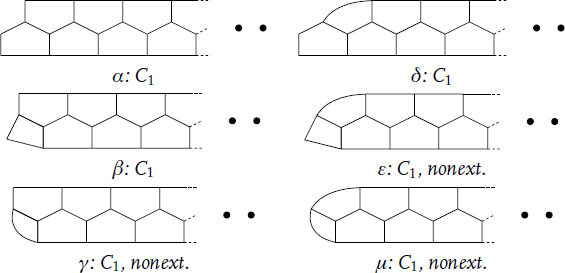14.3 Classification of Elementary ({2, 3, 4, 5}, 3)-Polycycles
For 2 ≤ m ≤ ∞, denote by Barrelm the ({5}, 3)-polycycle with two m-gonal holes separated by two m-rings of 5-gonal proper faces. This polycycle is nonextensible if and only if m ≥ 6. Its symmetry group, Dmd, coincideswith the symmetry group of the underlying 3-valent plane graph if and only if m ≠ 5. See below for pictures of Barrelm for m = 2, 3, 4, 5, and ∞:

Theorem 14.3 The list of elementary ({2, 3, 4, 5},3)-polycycles consists of:
(i) 204 sporadic ({2, 3, 4, 5},3)simp-polycycles, given in Appendix 1.
(ii) Six ({3, 4, 5},3)simp-polycycles, infinite in one direction:

(iii) 21 = ![]() infinite series obtained by taking two ends of the infinite polycycles from (ii) above and concatenating them.
infinite series obtained by taking two ends of the infinite polycycles from (ii) above and concatenating them.
For example, merging α with itself produces the infinite series of elementary ({5},3)simp-polycycles, denoted by En in [12]. See Figure 14.1 for the first 3 members (starting with 6 faces) of two such series: αα and βε.
(iv) The infinite series of Barrelm, 2 ≤ m ≤ ∞, and its nonorientable quotient for m odd.
Proof. Take an elementary ({2, 3, 4, 5},3)simp-polycycle P that, by Theorem 14.2, is kernel-elementary. If its kernel is empty, ...
Get Analysis of Complex Networks now with the O’Reilly learning platform.
O’Reilly members experience books, live events, courses curated by job role, and more from O’Reilly and nearly 200 top publishers.

